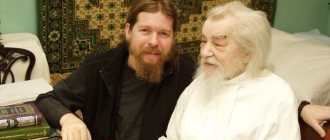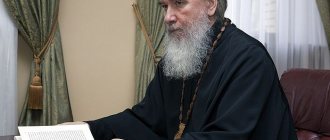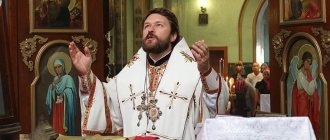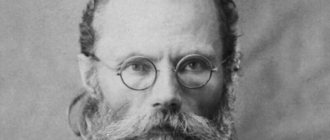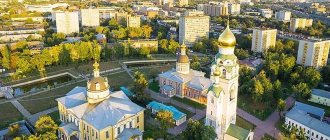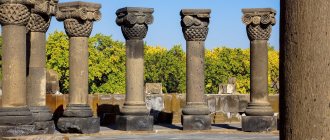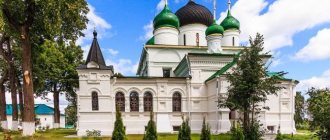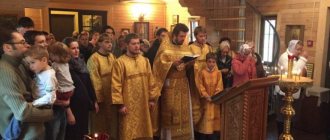According to legend, the monastery was founded by the monk Varlaam, who brought here the icon of St. Nicholas the Wonderworker from the Italian city of Bar. The elder wanderer Varlaam, a Rostov monk, traveled as a pilgrim to Greece, Palestine and Italy, to the city of Bar, in order to fulfill his cherished dream - to venerate the tomb of St. Nicholas.
During his visit to the city of Bar, he venerated the relics of the saint. After this, the saint of God himself appeared to the monk in a dream and ordered him to buy his image at an auction, promising to bestow grace and protection on the monk. With this image, he ordered him to go to Russia and settle with the icon where he would be shown again. The monk did just that. According to the instructions of the saint of God, he went to the auction and actually bought the image for three pieces of silver and immediately set off with it from Bar to his homeland. With great joy, safely under the protection of the miracle worker, the elder arrived in Russia in the city of Uglich on the very feast of the transfer of the holy relics of the saint on May 9, 1460. Here he stopped for several days, and then set off on the road to Rostov.
However, as soon as he walked 12 versts from Uglich to the Uleyma River, here in a deserted, wooded place he felt very tired, so that he could not continue his journey any further. Then the monk Varlaam stopped, placed the image of St. Nicholas on a pine tree between the branches, and after praying, he lay down on the ground and fell asleep. Waking up after a short sleep, he stood up and wanted to remove the icon from the tree in order to move on again, but as soon as he touched the image, his hands immediately weakened, and the image did not move from the tree.
The second and third time he tried to take the wonderful icon, and all without success. The elder was embarrassed by this and, not knowing what to do, lay down in grief and fell asleep. At night, a new appearance of St. Nicholas occurs to the elder, who hears the words of the wonderworker:
Stop here with my image, I want to glorify this place with my icon, and my monastery will be built in this place, the grace of God and my prayers will be here.
And indeed, as if to confirm the saint’s promise, miracles immediately began from his image.
Not far away, also on the Uleima River, was the village of Dubrovo. His peasants, having accidentally met Elder Varlaam, who had settled near the icon, and having heard from him about the wondrous deeds of the icon, immediately brought many sick people to him, and through the intercession of the wonderworker Nikolas they were all healed.
Residents of the surrounding areas built a chapel on the very road to Rostov, and the image was transferred there.
The news of this reached Prince Andrei Vasilyevich Uglitsky, who in 1469 ordered the construction of a monastery and the first wooden church in the name of St. Nicholas the Wonderworker to begin. In 1563, the Uglitsky prince Yuri Vasilyevich built here the wooden Church of the Entry into the Temple of the Blessed Virgin Mary, and in 1589, under Tsarevich Dimitri, a cathedral church was built in the name of St. Nicholas of Christ, where the miraculous image was transferred. The monastery was surrounded by a wooden wall. She owned several villages and hamlets.
In 1609, terrible trials began for the monastery. Together with the entire Russian land, the Nikolo-Uleima Monastery suffered during the Polish-Lithuanian intervention. According to the chronicle, when, having plundered Uglich, the regiments of the Polish king Zsigmont approached the monastery, the monks and residents of the village of Uleima and other surrounding villages, led by Abbot Barsanuphius, closed the gates, preventing the monastery from being plundered. The brethren and other defenders of the monastery closed themselves in the cathedral church, served the liturgy there and received the Holy Mysteries. Hegumen Barsanuphius, wanting to save the civilians who had found refuge in the temple, went out with 27 monks to the enemies. Having chanted a prayer service and kissed each other, they went out the gate. The monks were in ceremonial vestments, carried icons and banners, and walked singing, wanting to reassure the Poles so that they would spare the monastery and people. The Lithuanians rushed like lions towards the abbot and cut off his head. The enemies broke into the open gates and killed the monks, then tried to enter the cathedral. Embittered by the steadfastness of the monastery’s defenders, the Poles and Lithuanians undermined the walls of the monastery cathedral, under which there were deep basements, and blew up the cathedral. The temple collapsed with a deafening thunder that could be heard ten miles away. Two thousand defenders of the monastery died under the rubble of the cathedral: monks, peasants with their wives and children.
These tragic events are captured in the poem “The Old Fortress” by local poet V.N. Smirnov:
The light in the lamp flickers. There is a child's cry and the smell of candles, And outside the window the effervescent speech of others splashes ominously.
There, representatives of Europe, doing hard work, are digging under the church, carrying kegs of gunpowder.
The time has come for the unfortunate: Who is the winner - the dispute is over, A heavy explosion shook the area. Donkey, the cathedral crumbled.
The calm Ulema flows from the forest swamp side. Death stares at the empty eyesores from behind the destroyed wall.
The entire region was plundered and wounded. Enemies are tearing your living body, Pozharsky and Minin are calling your native Rus' on the battlefield.
The most despicable people of Poland and Lithuania came running to this beautiful and wondrous monastery and, having gathered around it, like bees of a hundred and like wolves, the courtyard of this verbal sheep, under compulsion, wanted to take it quickly. The abbot, the brethren, and the worldly people strongly resisted, but a great number of “all-evil enemies” overcame them. Then we went to the cathedral church, performed the Divine Liturgy, confessed, received Holy Communion of the Body and Blood of Christ, and prepared for the hour of death. Hegumen Barsanuphius commanded the brethren and all those who were in the church not to be afraid of death, “but rather to rejoice, as they are worthy of martyrdom, and the martyrs will inherit the Kingdom of Heaven, as they say, to those who were beaten.” “The curses of Lithuania, who are on guard, rushed like lions towards the monks and cut off the head of Abbot Barsanuphius.” “Polyakov (...) began to chop the swords of the brothers and cut them into pieces twenty-seven times.” The execution was deliberate: deep ditches around the cathedral church were trenched and the foundation was broken. The monks and the elite of the world, who were in the church, were all beaten by the falling church building. And the ministers who remained in the monastery say that up to fifty monks who remained in the church were beaten by the stone building, while the worldly people were like 2 thousand. Ten miles away in the forest, the Christians hiding in the forest could barely hear the thunderclap of the church, who arrived in time and reliably said: like thunder rang out through the forests and valleys, and the earth shook to its depths. The miraculous image of St. Nicholas was caught up by an invisible hand, having flown through the air to the melting place of the fallen cathedral church, appearing, being found by the faithful and standing in a miraculous vision.
And 10 years later, when the monastery barely had time to recover, a detachment of Pan Mikulsky took it by storm, killing abbot Jonah and the brethren. And only after the final peace was concluded with Poland in 1620, through the prayers of St. Nicholas the Wonderworker, the monastery began to be renovated and populated.
Construction of the new St. Nicholas Cathedral on the basement of the previous one began in the 1620s, but the cathedral was consecrated only on May 9, 1677 by Metropolitan of Rostov Jonah Sysoevich.
The Vvedenskaya Church was built in the 16th century.
In 1707, noblewoman P. A. Naryshkina donated to the cathedral a piece of the relics of St. Nicholas the Wonderworker, brought to Russia by Tsar Peter I.
In 1713-1717, a gate church was built in the name of the Holy Life-Giving Trinity.
In 1764, during the secularization reform, it received supernumerary status (that is, did not receive funds from the treasury), but in subsequent times it retained great importance and enjoyed fame thanks to a particle of the relics of St. Nicholas the Wonderworker and a revered icon. The churches of the monastery - the cathedral in the name of St. Nicholas, the Vvedenskaya and Trinity churches - were rebuilt several times in the 18th-19th centuries.
By the beginning of the 20th century, the St. Nicholas Uleiminsky Monastery became one of the most notable spiritual and cultural centers of the region. He enjoyed great love not only in the surrounding villages and hamlets, but also among the people of Uglich for the miraculous icon of St. Nicholas the Wonderworker, for the solemn service, for exemplary housekeeping, for the ringing of bells, heard even in the city of Ulema, more than 10 kilometers away. And not surprising, since it weighed 625 pounds. By 1908, the monastery owned 241 acres and 761 square fathoms of land, there was a water-powered flour mill, and a number of donated wastelands were assigned to the monastery. In the fence there was a building of brethren with cells, a school and a teahouse where pilgrims were received. The monastery owned securities worth 41,260 rubles, received 711 rubles and 42 kopecks of state support per year, its brethren owned 18,195 rubles 50 kopecks, and the capital of the monastery school was 400 rubles.
On holidays, the service at that time was performed in the Church of the Life-Giving Trinity, which was connected to the abbot’s chambers, where the archimandrite lived. He occupied rooms on the second floor, where there was his office, bedroom and sacristy. The vestments were marginal, blue; velvet silver. A Christmas tree was arranged for the children at the monastery school, on which small gifts were hung, which were then distributed to the children.
In 1917, rallies were held in the village of Uleime. Archimandrite Ambrose called on believers: “If the church is closed, I will sound the alarm. Come defend." The last archimandrite of the monastery was Pavel (Chistyakov).
In 1930, by decision of the collective farm meeting, the monastery was closed. Church utensils were taken to museums in Uglich and Yaroslavl.
The monastery was used for a school, cattle farms, and grain storage; The temples were used both as a prison camp (since 1938), and as an orphanage (in 1941-1957), and as a psychoneurological orphanage boarding school. In 1941, the roofs were removed from the towers and the towers were converted into fortifications to repel the enemy. Anti-tank ditches stretch to the northwest, northeast and southeast. All this accelerated the destruction of the monastery. The southeast tower was half destroyed. In the 1950s, the cross on the bell tower of St. Nicholas Cathedral burned down due to a thunderstorm.
In 1992, the St. Nicholas Uleiminsky Monastery was transferred to the Russian Orthodox Old Believers Church (Belokrinitsky Consent). After which, with God’s help, the revival of the monastery began and continues to this day. Philanthropist L.L. made a significant contribution to the restoration of the entire complex. Belomestnykh.
On May 28, 1993, on the day of the 400th anniversary of the death of Tsarevich Dimitri, a prayer service with blessing of water was held in the St. Nicholas Church of the monastery. This was the first service after the closure of the monastery and the first service of the Old Believers within these walls.
In the fall of 2001, Metropolitan Alimpy (Gusev) consecrated the altar of the Trinity Church, where further services were held.
On August 22, 2009, Metropolitan Korniliy (Titov) led the rite of consecration of the Vvedensky Church.
In November 2022, work was completed to improve the territory of the monastery and build roads.
After restoration work in the Trinity Church, on July 29, 2022, the boundary of the Prophet Elijah was consecrated, and on November 13, 2022, the boundary of the Apostle Philip.
Today it is a beautiful, prosperous monastery with a full range of cathedral vigil services to Orthodox saints every day, and through their holy prayers we hope to enter the heavenly abodes of the Heavenly Kingdom, in which may the Lord help us, to Him be glory, now and ever and forever and ever! Amen!
Organization of excursions to the Moscow Preobrazhensky Old Believer Monastery
Moscow Preobrazhensky Old Believer Monastery
In 2022, the project Virtual Museum of the Moscow Transfiguration Old Believer Monastery was launched on the Pomeranian North website
Preobrazhenskoye is a unique historical corner of Moscow, one of the main historical milestones of which, starting in 1771, is closely connected with the emergence here of the center of the Old Believers-Bezpopovtsy of the Fedoseev Consent.
The foundation of the Moscow community was laid in 1771, at a time when the plague was raging in Moscow. On September 14, 1771, at the request of the merchants Fyodor Anisovich Zenkov, who owned a cloth factory, and Ilya Alekseevich Kovylin, who had brick factories on the outskirts of Moscow, a quarantine was established in Preobrazhenskoye to care for the sick, and the dead were buried here in the cemetery. Initially, the established quarantine was called the Preobrazhenskoye Cemetery (By Decree of Catherine II it was forbidden to bury those who died from the plague within the Moscow city limits). Gradually, the center grew more and more, attracting merchants who, often coming from the people's environment, were drawn to the people's church. Already at an early stage in the history of the Preobrazhenskoe cemetery, it was headed by prominent and active entrepreneurs of that time, such as I. Kovylin. Later, by the accession of Alexander I to the throne, the names of wealthy Fedoseevites were known throughout Moscow: Zenkov, Kovylin, Shalaputin, Grachev, Sokolov, Bolshov and others.
At the beginning of the 19th century, the community's ownership was divided into two parts - the men's and women's courtyards. The men's courtyard with the Assumption and Holy Cross churches (chapels) was expanded and surrounded by a jagged stone wall with hipped towers. Strict monastic regulations were in effect on the male and female halves. In fact, two monasteries appeared here. The architectural ensemble of the Transfiguration Monastery took shape over 27 years - from 1784 to 1811, when the stone Holy Cross Chapel was erected in the women's courtyard. The chapels, as well as almshouses with prayer rooms in the women's courtyard, were built by the talented architect Fyodor Kirillovich Sokolov (1760-1824).
On May 15, 1809, Alexander I, by his decree, approved the plan for the establishment of the “Preobrazhensky Almshouse” and ordered it to be called that officially from now on, giving it the rights of a private charitable institution. By that time, more than 1,500 people lived in the community, and the number of parishioners exceeded 10,000; the children's ward accommodated up to 200 young children. The new charitable organization was given the right of self-government, unaccountable management of its capital, including the development of commercial commerce.
In August 1812, before the French army entered Moscow, about 300 carts loaded with valuables and important documents, ancient icons and books left the Preobrazhensky almshouse for the village of Ivanovo, Vladimir province. More than 200 girls and young women, nuns of the monastery, were also sent there. Many men who lived in the monastery scattered, leaving only the sick and old people. The prayer rooms were closed, and services were held only in the large chamber in the Men's Courtyard.
In the post-war period, the economic life of the community revives. By the 1830s, 32 large and 120 small factories producing woolen, cloth, silk and paper products were associated with the community. Thus, F.A. Guchkov owned the largest factory in Moscow at that time. To understand the role of the Preobrazhensky Almshouse, it is appropriate to quote the words of the Minister of Finance Ivan Alekseevich Vyshnegradsky: “Our Christ-loving Old Believers-Preobrazhensky are a great force in the Russian trade and factory business, they founded and brought our domestic factory industry to its fullest perfection and flourishing state.”
During the reign of Nicholas I and Alexander II, the times of brutal repression against Old Believers returned.
In the 1840s, a real threat of ruin and even complete destruction hung over the Transfiguration Monastery. In this situation, the Fedosevo residents are planning to prepare for the establishment of a monastery in a safe place abroad (in Prussia), where the Moscow center of priestlessness and its shrines could be moved. This is how the priestless Voynovsky Monastery appeared (now near the town of Voynovo in Poland). However, later circumstances changed for the better and this plan was abandoned. The buildings of the Voynovsky Monastery still remain, and the Orthodox convent of the Fedoseevites is now located there.
In 1854, the Assumption Church and the Exaltation of the Cross Gate Chapel were taken away from the Fedoseevites and handed over to their co-religionists. More than one and a half thousand ancient wooden icons collected by Old Believers also went to fellow believers. The entire territory of the men's courtyard with all buildings and property was finally taken away from the Old Believers, and in 1866, on this territory, the dominant church opened the St. Nicholas Edinoverie Monastery, the main goal of which was to fight the Old Belief. Those in custody on the territory of the men's courtyard are transferred to the buildings of the women's courtyard. The period 1905 - 1917 is the period of the Old Believers gaining real religious freedom. During this period, the community manages to do a lot. Spiritual and economic life comes to life. A school for boys and girls is opened, a printing house and an icon-painting workshop are created. In 1912 According to the project of the architect L.N. Kekushev, a hospital with 75 beds, equipped with modern medical equipment, was being built, which during the First World War, by decision of the Fedoseevites, was provided for the treatment of wounded front-line soldiers. The First World War and the revolution that broke out in 1917 prevented the implementation of many of the plans of the Fedoseevites.
In 1923, the St. Nicholas Monastery of Edinoverie was closed and the authorities handed over the Assumption Church to the Renovationists (schismatic reformers within the ruling Church). In the 1930s, the authorities closed the Church of the Old Believers-Pomeranians in Tokmakov Lane, and the community was asked to occupy part of the Assumption Church. In the 1940s, the church parish of the Renovationists, who occupied the Nikolsky limit, ceased to exist and its place was taken by the community of the Moscow Patriarchate.
During the years of Soviet power, all the remaining almshouses with prayer houses were taken away from the Fedoseevites, with the exception of the Holy Cross Church. In the eastern part of the seized territory, in the 1930s, the authorities organized an agricultural market, which still exists today. In the 1990s, some of the buildings were returned to Fedoseev residents and repaired by the community. Currently, on the territory of the former Transfiguration Monastery there are communities of the Fedoseyevsky Harmony, Pomeranian Old Believers and the parish of the Moscow Patriarchate of the Russian Orthodox Church. Also nearby is the territory of the Preobrazhensky necropolis, which, in fact, gave birth to the main spiritual center of the Old Believers-bezpopovtsy. Today there are graves of both famous Old Believers (many of the burials are family) and the graves of those killed during the Great Patriotic War.
All questions arising in connection with the organization of the excursion can be asked by contacting us.
Capture of the Transfiguration Monastery in Moscow: commentary by Mikhail Shakhov
We are publishing a conversation between Svetlana Solodovnik and prof. Mikhail Shakhov, executive secretary of the Council of the Moscow Preobrazhensky Old Believer Community of Christians of the Old Pomeranian Concord, dedicated to the raider seizure of the buildings of the Preobrazhensky Monastery in Moscow, and the upcoming trial.
There has been litigation for the Old Believer Transfiguration Monastery in Moscow for almost 10 years. The monastery was built in the 18th century; its churches contain many ancient icons. But they are not the only ones of value: 11 hectares of monastery land and many buildings are a constant temptation for dishonest businessmen who dream of taking possession of this wealth. The fact is that when the monastery, like many other religious buildings, was destroyed in 1932, the Preobrazhensky Market was erected on the site of the demolished cells of the Old Believer almshouse, which is still operating. And so they lived: a lively agricultural market and the Church of the Exaltation of the Holy Cross, which was never closed during the Soviet period and was constantly used for worship.
When in the early 1990s the monastery was handed over to the Old Believers and plans began to be made for restoring the entire ensemble of the monastery, they planned to move the market outside the monastery territory. But while the Moscow authorities were gathering, at the beginning of 2011, a piece of almost 4 hectares of land on which the market is located was excluded from the territory of the monastery by order of Rosokhrankultura and removed from the restrictive provisions of the law “On Objects of Cultural Heritage”. An area has emerged inside the monastery territory that is available for privatization and development, which not only impedes the restoration of the ensemble as a whole, but also excites the imagination of potential raiders. And not even potential anymore...
A year before the land was taken away from the monastery, a certain Gennady Medvedev, who at one time claimed to be the director of the Preobrazhensky Market, gained the trust of one of the Pomeranian communities and actually seized five buildings of the monastery by raider. Medvedev did not stop there.
In May 2015, the Territorial Administration of the Federal Property Management Agency transferred six buildings of the Preobrazhensky Monastery to the religious organization “Preobrazhensky Old Believer Monastery of the Ancient Orthodox Catholic Church of the Old Pomeranians-Fedoseevites” for free, indefinite use, where Medvedev is listed as the manager. Note that all six “newly transferred” buildings and eight more at Preobrazhensky Val, building 17-25, have since 1993 belonged to the Council of Orthodox Church Parishes of the Preobrazhensky Monastery, to which, in fact, on the basis of a decree of the Moscow government, the monastery was transferred in the early 1990s . The Council includes the Centralized religious organization "Old Orthodox Pomeranian Church", two Old Believer communities and one Orthodox parish. Later, in 2000, the Ministry of Culture of Russia and the Ministry of State Property made a repeated decision to transfer the monastery complex to the Council.
It is noteworthy that among the “newly transferred” buildings is the same Church of the Exaltation of the Holy Cross, which from the moment of its construction, that is, from 1811, always belonged to the Moscow Preobrazhensk Old Believers Community of Christians of the Old Pomeranian Concord, which is part of the Council of the Moscow Preobrazhenskaya Concord, the founder of the monastery. The last registration of her right of use in the form of a security agreement took place on August 31, 1995. That is, all six objects that were transferred to the so-called monastery of the Ancient Orthodox Catholic Church in May of this year have legal owners.
Another thing is interesting. By the decision of the Supreme Court of Russia, this same “Old Orthodox Catholic Church (Staropomorets-Fedoseevtsy)” was liquidated as a centralized religious organization (CRO) a year before its “monastery” buildings were transferred (March 18, 2014). However, the local religious organizations included in it, simply put, the communities, including this very “monastery,” raise many questions. To begin with, they all arose, as they say, en masse, suddenly. Four out of six in one month - September 2011. And two more next year - in May and September. All of them are registered at the same address: st. Preobrazhensky Val, 17, building 97, including the “monastery”. But what’s even more interesting: the property with this address is a grocery shopping pavilion at the Preobrazhensky Market, where there is not even a hint of the presence of not only a monastery, but even the tiniest community. The conclusion that organizations exist solely on paper is self-evident. Moreover, no one in the Transfiguration Monastery has ever seen their representatives live. In addition to the brutal manager of the liquidated RDCC Gennady Medvedev and the supposed abbot of the “monastery” Ipaty Ivanovich.
The monastery, naturally, did not remain indifferent to the seizure attempts. A complaint was sent to the Federal Property Management Agency with detailed explanations of who belongs to whom, on what grounds, and what. The complaint was considered and the mistake of the Territorial Administration was admitted: in September of this year, it was decided to cancel the transfer of buildings and terminate the agreement for free use. However, the troubles of the Transfiguration Monastery did not end there. Five buildings seized by the RDCC continue to remain controversial. On November 30, the Ninth Arbitration Court of Appeal is scheduled to hold hearings on the case of their removal from someone else’s illegal possession.
We talked about the difficult struggle of the monastery for the right to remain united with the executive secretary of the Council, Professor Mikhail Shakhov. The conversation was conducted by Svetlana Solodovnik.
Can we no longer worry about the fate of the buildings transferred by the “May” decision?
I really want not to worry, but the court decision has not yet entered into legal force and can be appealed by the “monastery.” The physical buildings remained with the Council. But the contract with the “monastery” concluded at the same time by the Territorial Agency for the transfer of buildings for free use still remains to be terminated. I would like to draw your attention to the pace of the operation: the law allows two years for the transfer from the date of filing the application, if the building does not need to be vacated, if necessary, then six years. And then in two weeks they drew up a decision, a contract for free use and an act of acceptance and transfer of buildings - the latter, of course, is fictitious. The Federal Property Management Agency signed the deed of transfer of buildings that it did not physically transfer to the “monastery.”
How did it happen that the Federal Property Management Agency did not know that the buildings of the Transfiguration Monastery already belonged to someone - isn’t there a general register that would indicate who owns what?
Formally, the Federal Property Management Agency took the following position: the monastery buildings are federal property, therefore the 1993 resolution of the Moscow government and the transfer of the buildings to the Council are null and void. Only after all the complaints and protests did the department agree that the Council was the rightful owner. At the same time, in 2012, the buildings at the Preobrazhensky Monastery were inspected by the Terrestrial Agency of the Federal Property Management Agency; the inspectors communicated with members of the Council, so it was impossible not to know that the buildings belonged to him.
In addition, the law on registration of rights to real estate has been in force since 1998, so everything that was transferred before 1998 has legal force, but is not reflected in the register. It’s a very convenient excuse for officials: our computer doesn’t show it in the registry, which means the building is nobody’s property.
Is the entire monastery in federal ownership?
No, for more than 20 years the question of whether the ensemble of the Preobrazhensk Old Believer community belongs to federal property or to the property of the city of Moscow remained unsettled. By order of the government of the Russian Federation, part of the buildings of the ensemble (13 objects) in 2013 were classified as federal property. This decision was made contrary to the position of the Council, which was supported by Patriarch Kirill. Back in 2011, he proposed in a letter to the Minister of Economic Development Elvira Nabiullina to include the monastery in the list of monuments to be transferred to Moscow when delineating property rights between the Russian Federation and the city. At a meeting organized by the Federal Property Management Agency on December 25, 2012, representatives of the department were unable to give any explanation why these objects were being distributed into federal ownership and not into the ownership of Moscow.
As a result, the ensemble was divided between two owners - the above-mentioned 13 objects are classified as federal property, and the other 14 objects, which are not monuments of national significance, but are also part of the ensemble and located in close proximity to federal property, belong to Moscow. Some of them have the status of a cultural heritage site of regional significance or an identified cultural heritage site. There are no legal grounds for the seizure of these buildings into federal ownership.
Does the monastery Council of Old Believer Communities include one Orthodox parish? Why?
The council was created in 1992 in order not to divide the monastery ensemble into parts between religious organizations that existed on the territory of the Transfiguration Monastery for many years. Orthodox parish of St. Nicholas has existed since the post-war period. The council coordinates the activities of communities and acts as the sole title owner of the land and property complex.
Do Old Believers even have monasteries?
There is practically no monasticism among the Bespopovites now; the last convent of the Fedoseyevites ceased to exist in Poland in the 1980s. The Transfiguration Monastery had never been called a “monastery” before; the tsarist authorities did not allow it. Officially, it was called the “Preobrazhensky Almshouse,” but in addition to the homeless and orphans, nuns, singers, and mentors lived here, replacing priests for the priestless people. Now the mentors live, some of the singers live, parishioners and out-of-town pilgrims stay.
Are there any statistics on how many objects have been transferred to religious organizations, what percentage of the state’s religious property is, and what is the percentage of refusals?
Until 2014, the Federal Property Management Agency for more than 3 years simply ignored the requirement of the law to publish in the public domain all requests for the transfer of property. Only after an appeal from the editors of Religion and Law in January 2014, information about the transfer appeared on the website of the Federal Property Management Agency, which was extremely inconvenient for statistical generalization and was very late. The website of the Federal Property Management Agency for Moscow refers to a federal list in which the story of the Transfiguration Monastery is not reflected at all. There is also a page on the Agency’s website. The transfer of property belonging to Moscow is presented on the website of the Moscow Property Department and also does not provide generalized information.
When they transfer property to religious organizations, do they somehow find out who is in front of them or not? Maybe some kind of examination is being carried out - are they really Old Believers, and not scammers?
The law on the transfer of property contains a “rubber” wording: “The transfer of property for religious purposes to religious organizations is carried out by an authorized body, taking into account the religious affiliation of the specified property...” (clause 4 of article 3), which does not oblige the transfer of property in strict accordance with the confessional affiliation and opens possibility of arbitrary transfer. The law provides for the submission of controversial cases to the commission for consideration (Article 9). But to do this, you need to know that a decision on the transfer is being prepared, and file a protest. In our case, the decision was made two weeks after submitting the application - and we accidentally found out about it a month later.
According to unofficial information, the Federal Property Management Agency consults with the Ministry of Justice and the Financial and Economic Administration of the Russian Orthodox Church (even on Old Believer objects) before transferring each object, but in our case there were no consultations. “For inexplicable reasons,” the Federal Property Management Agency decided to entrust six buildings—historical and cultural monuments of federal significance—to an organization that came from nowhere and has a legal address in a trade pavilion on the market.
Why was the “Russian Ancient Orthodox Catholic Church” liquidated?
Due to violations during its creation. To register a central religious organization, it must include at least three local religious organizations. I note that all three organizations that were the founders of the RDCC were located in remote villages of the Kirov and Nizhny Novgorod regions. At the time of the creation of the RDCC in 2006, one of the three organizations that were part of it no longer legally existed - it was liquidated as having ceased its activities.
However, despite all the raider actions of the RDKTs - one was even talked about on NTV - the police and the prosecutor’s office refused to open a case against it, and the Ministry of Justice could only stop their activities.
However, the liquidated RDCC still holds five monastery buildings illegally occupied by it in another part of the Transfiguration Monastery ensemble. How did the capture even become possible?
At first, these buildings housed a male Old Believer monastery, and from the middle of the 19th century, the tsarist authorities expelled the Old Believers and handed over this part of the monastery to fellow believers. After the revolution, some co-religionists recognized Soviet power, while others did not; the Church of the Exaltation of the Holy Cross was divided in half. Over time, the community that did not recognize Soviet power was expelled - and Old Believers took its place. An employee of the Moscow Pomeranian Old Believers Community, who was entrusted with the technical management of these buildings and the management of security, who abused the trust of the Pomeranian Old Believers, refused to obey the decision to remove him from office. Instead, he presented an agreement that had obvious signs of forgery, according to which the rights to five buildings for 20 years (from 2006) were transferred to RDCC.
Despite the fact that the RDCC was liquidated by the Supreme Court, it has not yet completed the work of the liquidation commission and has not been excluded from the Unified State Register of Legal Entities. No one cares that the liquidated RDCC continues to exist and operate. By the way, the large shopping pavilion at the Preobrazhensky Market, owned by the RDCC (!), was ordered by the court to be demolished more than two years ago as an unauthorized building. But the pavilion is still trading successfully. And no one cares about non-compliance with a court decision. The RDCC housed two dozen commercial firms in the seized buildings, the rent from which brings in hundreds of thousands of rubles a month. It is not surprising that with such income there is enough to pay for lawyers. The eviction trial is now in its fifth year; the trial was artificially prolonged with active assistance provided to the RDCC in court by the Federal Property Management Agency. But let's see how the court hearing on November 30 ends.
| Tweet |
Show articles
Links to this article
[2]:
loading …
